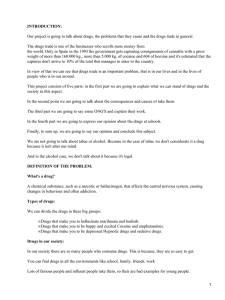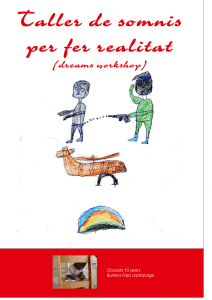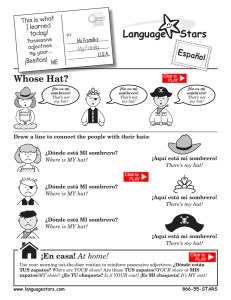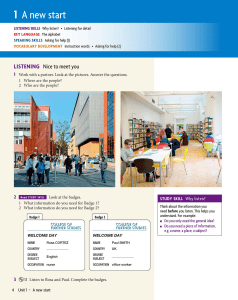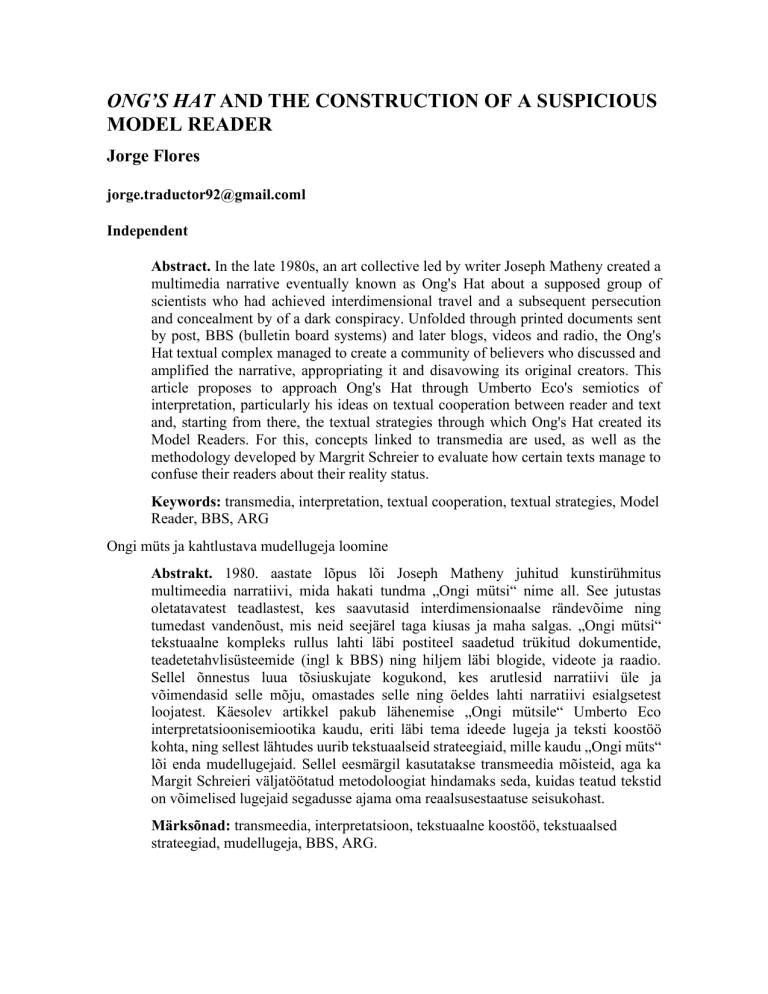
ONG’S HAT AND THE CONSTRUCTION OF A SUSPICIOUS MODEL READER Jorge Flores [email protected] Independent Abstract. In the late 1980s, an art collective led by writer Joseph Matheny created a multimedia narrative eventually known as Ong's Hat about a supposed group of scientists who had achieved interdimensional travel and a subsequent persecution and concealment by of a dark conspiracy. Unfolded through printed documents sent by post, BBS (bulletin board systems) and later blogs, videos and radio, the Ong's Hat textual complex managed to create a community of believers who discussed and amplified the narrative, appropriating it and disavowing its original creators. This article proposes to approach Ong's Hat through Umberto Eco's semiotics of interpretation, particularly his ideas on textual cooperation between reader and text and, starting from there, the textual strategies through which Ong's Hat created its Model Readers. For this, concepts linked to transmedia are used, as well as the methodology developed by Margrit Schreier to evaluate how certain texts manage to confuse their readers about their reality status. Keywords: transmedia, interpretation, textual cooperation, textual strategies, Model Reader, BBS, ARG Ongi müts ja kahtlustava mudellugeja loomine Abstrakt. 1980. aastate lõpus lõi Joseph Matheny juhitud kunstirühmitus multimeedia narratiivi, mida hakati tundma „Ongi mütsi“ nime all. See jutustas oletatavatest teadlastest, kes saavutasid interdimensionaalse rändevõime ning tumedast vandenõust, mis neid seejärel taga kiusas ja maha salgas. „Ongi mütsi“ tekstuaalne kompleks rullus lahti läbi postiteel saadetud trükitud dokumentide, teadetetahvlisüsteemide (ingl k BBS) ning hiljem läbi blogide, videote ja raadio. Sellel õnnestus luua tõsiuskujate kogukond, kes arutlesid narratiivi üle ja võimendasid selle mõju, omastades selle ning öeldes lahti narratiivi esialgsetest loojatest. Käesolev artikkel pakub lähenemise „Ongi mütsile“ Umberto Eco interpretatsioonisemiootika kaudu, eriti läbi tema ideede lugeja ja teksti koostöö kohta, ning sellest lähtudes uurib tekstuaalseid strateegiaid, mille kaudu „Ongi müts“ lõi enda mudellugejaid. Sellel eesmärgil kasutatakse transmeedia mõisteid, aga ka Margit Schreieri väljatöötatud metodoloogiat hindamaks seda, kuidas teatud tekstid on võimelised lugejaid segadusse ajama oma reaalsusestaatuse seisukohast. Märksõnad: transmeedia, interpretatsioon, tekstuaalne koostöö, tekstuaalsed strateegiad, mudellugeja, BBS, ARG. El sombrero de Ong y la construcción de un modelo de lector sospechoso Resumen. A finales de la década de 1980, un colectivo de autores liderados por el escritor Joseph Matheny, creó una narrativa multimedia, eventualmente conocida como Ong’s Hat, sobre un grupo de científicos que había conseguido viajar entre dimensiones y una posterior persecución y encubrimiento por parte de una oscura conspiración. Desplegado a través de documentos impresos enviados por correo (en el sentido tradicional), BBS (Bulletin Board Systems) y más tarde blogs, videos y radio, el complejo textual Ong’s Hat logró crear una comunidad de creyentes que discutieron y ampliaron la narrativa, apropiándose de ella y renegando de sus creadores originales. Este artículo plantea aproximarse a Ong’s Hat a través de la semiótica interpretativa de Umberto Eco, particularmente sus ideas sobre cooperación textual entre lector y texto. Partiendo de ahí, se analizan las estrategias textuales mediante las cuales Ong’s Hat perfiló a sus Lectores Modelo. Para ello, también se hace uso de conceptos ligados a la transmedialidad y a la metodologia de Margrit Scherier, para evaluar como ciertos textos consiguen confundir a sus lectores sobre su estatus de realidad. Palabras clave: transmedia, interpretación, cooperación textual, estrategias textuales, Lector Modelo, BBS, ARG 1. Introduction In the late 1970’s, in a forest in southern New Jersey, a community of theoretical scientists from Princeton, spiritual researchers, and avant-garde artists self-denominated the ‘Moorish Science Ashram’ – also founders of the ICS (Institute for Chaos Studies) – conducted research on ‘cognitive chaos’. By the ending of this decade, this group created a device designated as ‘the Egg’ which functioned as a heightened sensory deprivation chamber in order to achieve a state in which a person could experience the moment when a particle becomes a wave. During one experiment, the Egg disappeared with a person inside it. Moments afterwards, it appeared again, and the person inside of it told them of his experience: he had travelled to an alternate dimension, another planet, exactly like Earth, but without humans. After this accidental discovery, members of the ICS began traveling to this alternate dimension frequently until eventually many of them moved there, some even having offspring in that dimension. However, knowledge of this alternate dimension and the possibility of gaining access to it was silenced by several conspiracies seeking to deprive humanity of its potential (Matheny 2002). At this point, most readers might immediately feel suspicious about the veracity of this story, commonly referred to as Ong’s Hat, after the New Jersey ghost town where the conspiracy had supposedly taken place. Given how outlandish some of the details seem, one would be hard pressed to believe in it, but believe in it some did. In fact, in the late 90’s and early 2000’s a large online community formed around the Ong’s Hat narrative to actively discuss it, speculate about its authenticity, do research and ponder upon its implications if found to be true. When Joseph Matheny, one of the primary responsible figures for the creation and divulgation of the Ong’s Hat texts, announced the ending of the experiment, several members of the online community doubted him or plainly discredited him, believing he had either ‘sold out’ or been co-opted, or, even more interesting, believing that this announcement was another clue, a coded invitation to continue the search for Ong’s Hat (Kinsella 2011: 139-142). Even after the same Matheny called attention to the fictitious nature of it all in more recent years (New World Disorder Magazine: 2008; Paskin 2018), to this day there are people who still go to the Pine Barrens to look for the interdimensional gate. A ‘rational; reader may wonder: why? And the easiest answer might be that these readers have overinterpreted the Ong’s Hat text, effectively being unable to distinguish the line between fact and fiction. There is another possible answer: the text itself provoked that confusion. I propose there is a third possible answer: there is a dialectic relationship between the text and the reader which affords the confusion. In other words, the Ong’s Hat text contained in itself the possibility of being overinterpreted, a possibility that is actualised in the reader. In his book, Lector in Fabula (1994), Umberto Eco proposed that the text envisions and, what is more, constructs its Model Reader. In this paper I will try to argue that the Ong’s Hat text, through its complex and sophisticated textual strategies involving transmedia storytelling, hypermedia, and the problematization of phenomenal worlds, constructs a Model Reader that is an overinterpreter, a suspicious Model Reader. 2. A brief history of Ong’s Hat Ong’s Hat, also known as The Incunabula Papers, first appeared in the end of the 80’s and beginning of the 90’s. The phenomenon was spawned by two printed documents: Ong’s Hat: Gateway to the Dimensions! A Full Color Brochure for the Institute of Chaos Studies and the Moorish Science Ashram in Ong’s Hat, New Jersey and Incunabula: A Catalogue of Rare Books, Manuscripts & Curiosa—Conspiracy Theory, Frontier Science & Alternative Worlds (Matheny: 2002). Ong’s Hat: Gateway to the Dimensions! was the first to appear. It was a brochure sent out by post to several addresses, containing the detailed plot of the Ong’s Hat story summarised above. A crucial aspect to bear in mind is that it is framed as an authentic document, albeit a secret document, written by anonymous members of the Institute for Chaos Studies (ICS) and “disguised as a sort of New Age vacation brochure” (Matheny 2002: 58, italics in the original). Another key aspect of it, is that it is not only a historical account of the development of interdimensional travel in Ong’s Hat and what happened afterwards, but it also delves at length into explanations of how interdimensional travel was achieved, referencing complex theoretical physics and mathematics, particularly chaos theory, relativity and quantum mechanics, all combined with a new age mixture of tantric beliefs and psychedelic experimentation. The brochure is open ended, explicitly inviting speculation about whether or not the revelations will continue. The Incunabula catalogue appeared some time later, supposedly published by a man named Emory Cranston and distributed in the same manner as the Ong’s Hat: Gateway to the Dimensions! brochure. It was – as its title announced – a catalogue of brochures, pamphlets, scientific studies, testimonies, journals, and pulp and science fiction (some of them real and some of them non-existent). Each of these sources appears with a summary and comments which, altogether, read as a narrative expanding the Ong’s Hat universe, providing more details about the people involved (the ICS and the Moorish Science Ashram), their ideas, beliefs and motivations, their experiments and more scientific material supporting the possibility of interdimensional travel. By the end of 1992, a third document appeared. It was published by a man named Joseph Matheny, who was purportedly investigating the authenticity of the two first documents. It was written as a journal entry, dated on October 13, 1992, and most of it is a transcription of an interview with Nick Herbert, a physicist cited in the Incunabula catalogue. In the interview, Herbert speaks about quantum tantra and alternate dimensions, both topics that Herbert has written about (in real books that can even be purchased on Amazon). The interview is stopped after Matheny asks Herbert about interdimensional travel and the Egg crafts used for it. Finally, in 1994, Matheny published another entry in his journal, dated on January 23 that same year. In it, he transcribes a phone interview with Emory Cranston, the supposed editor of the Incunabula catalogue. The interview focuses on the catalogue and some of the entries in it, but as it progresses it becomes a very ambiguous testimonial of interdimensional travel. Cranston confesses being part of the interdimensional cult (ICS and Moorish Science Ashram) and having visited Java2, an alternate Earth. This interview, like the one with Herbert, is also stopped abruptly. But Ong’s Hat: Gateway to the Dimensions!, the first document, had appeared before it was sent as a brochure. It had appeared in a science fiction ‘zine’ (a self-published magazine also sent through the mail service) as a short story in 1988. It was written by Peter Lamborn Wilson, (a.k.a Hakim Bay) (Kinsella 2011: 80). Joseph Matheny, an acquaintance of Lamborn Wilson, read this short story and thought he could use it to start an experiment. With the help of Lamborn Wilson and a visual artist named James Koehnline, Matheny edited Ong’s Hat: Gateway to the Dimensions! to make it look as a brochure, then sent hundreds of xeroxed copies to a remailing system in Hong Kong, which in turn sent it to hundreds of addresses provided by Matheny in the U.S., addresses of friends, acquaintances and members of the mailing community who were already receiving zines on fringe topics related to conspiracy theories, science fiction, and new age philosophy. The brochure would then arrive as if it had been originally mailed from Hong Kong, with no trace of the original senders. Using the same method, the group distributed their second collaboration, Incunabula, written again by Lamborn Wilson and illustrated by Koehnline. This second collaboration marked the end of the group of co-authors. From then on, Matheny continued alone, penning the two aforementioned interviews. In 1993, being an enthusiast of bulletin board systems (BBS)1, Matheny saw potential in that medium and decided to post the Ong’s Hat texts there. When the internet became more widespread, he created incunabula.org, where he transferred the archive from the bulletin boards and started adding articles and chats referencing Ong’s Hat. Matheny also began creating several websites related to the topic, interconnecting all of them through hyperlinks in texts, images, graphics, etc., so new potential readers would have more than 1 A form of electronic message board made possible by a networking of computers through a phone line, a precursor of the internet that was used during the 80’s and 90’s. one access way to the Ong’s Hat universe (Paskin 2018). Once online, the community around the Ong’s Hat mystery grew and with it, the text itself expanded, forming a continuously growing, self-feeding textual complex. Platforms for discussion independent of Matheny were set up, such as www.interdimension.org and very prominently, DarkPlanetOnline, where members of the community would debate, share thoughts, hypothesis, experiences, and plan trips to Ong’s Hat (Kinsella 2011: 71). In spite the expansion of the Ong’s Hat text now exceeding Matheny’s control, he remained the leading figure and content procurer for the community, publishing an interactive ebook (Matheny 2002[1999]), an interview with people that supposedly lived in the Ashram at Ong’s Hat as children (Matheny 2000), and even appearing in the radio show: Coast to Coast (Bell: 2000). It is important to remember, however, that for this community, Matheny was not the author of the Ong’s Hat mystery, but a member of the community, a pioneer with further research conducted than most of them, and, in that sense, an authority, but not an author. Eventually and predictably, the story acquired a life of its own for the members of the community. Though some of them remained fairly sceptical and participated out of curiosity, for fun, or as an opportunity to bond with other people with similar interests, others were truly enticed by the possibility of the Ong’s Hat papers being authentic or at least being based on reality. Between 1999 and 2001 – the peak of interest in Ong’s Hat – several members built on the original mythos tying it with personal experiences, with other speculative literature, with other conspiracy theories, and, what is more interesting, some believed they were experiencing supernatural events in the form of “synchronicities” (coincidences), vivid dreams about parallel universes, sights of otherworldly creatures, voices, etc. (see transcriptions of the original testimonies and debates in Kinsella 2011: 85-148). Among these devoted members of the community, however, a rift occurred after Matheny appeared on the radio show Coast to Coast in 2000. Some started suspecting everything was a hoax that Matheny created to get media attention and felt betrayed. Others believed in Ong’s Hat so ardently that they wanted to go further into it and thought Matheny had the key, so some of them tracked him down and started knocking on his door, peeking through his windows, and sleeping in his yard (Paskin 2018). In the summer of 2001, two seminal alternate reality games (ARG) were launched: The Majestic by Electronic Arts and The Beast by Microsoft (Szulborski 2005). Members of the community were worried about big companies appropriating the kind of interactive, openended story complex Ong’s Hat had pioneered. This discouraged some of the members of the community, and Joseph Matheny, who was already discouraged by the people who had taken the story too seriously, saw the appearance of those ARG as the final nail on the coffin for Ong’s Hat2 and decided to put an end to it. In August 2001, in the main message board, he wrote: 2 To understand why the appearance of those ARG was so disappointing to Matheny, one should understand his purpose in starting the Ong’s Hat experiment. “Talking to each other and telling stories is something that we’ve always done, and it’s something we’ve kind of turned over to merchants in a lot of ways so I try to find subversive ways to bring people back around and let them know they’re the storytellers” (interviewed by Paskin 2018). Even more telling is a quote by Dostoevsky posted in his official website: “You cannot imagine what wrath and sadness overcome your whole soul when a great idea, which you have long cherished as holy, Ong’s Hat Tantric Egg Research Center was a necessary ruse for deflecting attention from our real project-- to open up your conduits, brother and sisters, to rip off the confining condom of language and to Fuck Nature Unprotected (qtd in Kinsella 2011: 139). The response by the community was mixed. Many were disappointed, some were angry, but others among the most committed members disregarded the statement by Matheny and thought the outcome of it would eventually prove positive, since it would eliminate the unconvinced members and leave only the deserving ones. Read, for example, this post by user Harla Quinn: Hey, no matter what everyone’s interpretation of the “official statement”, the themes and science have a helluva lot of validity - I think EVERY ONE here knows that which is why you are HERE and not joining in the chorus line elsewhere - and my efforts toward untangling the quantum entanglement question for me doesn’t end with an ‘announcement’ […] the “best” we can hope for from the recent exodus is that there won’t be anymore disruption underfoot. [...] The Majestic gamers will look for their clues and move on to the next level. The newbies and naysayers will point and laugh and pat themselves on the back that they “got it”. (snicker) All that serves to clear the board which is fine by me. (qtd in Kinsella 2011: 142). In spite of the statement, the quest to solve the Ong’s Hat mystery did not stop immediately, but without Matheny’s leadership and production of texts, the community slowly dispersed until it eventually disappeared, and all forums were abandoned and eventually taken offline. However, the influence of the Ong’ Hat text did not end with the community nor with the forums. As it was previously mentioned, there are still people who travel to The Pine Barren’s forest in New Jersey in search of the interdimensional gate, either with serious curiosity or with an ironic detachment. Moreover, some of the ideas in the Ong’s Hat story have been absorbed by current conspiracy theories, such as QAnon (Coaston 2018) and The Montauk Project (González 2016). 3. Text interpretation The Ong’s Hat phenomenon constitutes a deeply interesting object to be analyzed from a textual interpretation perspective. Ong’s Hat is a text, or more accurately, a textual complex formed of the thousands of chats, videos, interviews, audio recordings, etc. Even though we should keep in mind that Ong’s Hat technically has hundreds of authors, we will focus on Matheny as the main author. We know that the whole phenomenon originated with two main texts: first, Ong’s Hat: Gateway to the Dimensions! and then the Incunabula catalogue. Locating us at the metalevel, we know that these two documents have empirical authors: Matheny, Lombard Wilson (the actual writer of the texts), Koehnline and Herbert, with Matheny being the preeminent author of Ong’s Hat as a project, giving it was his idea to repurpose Lombard Wilson’s stories and use different media to get to an audience. It follows that we can trace the origins of the Ong’s Hat textual complex to Joseph Matheny. is caught up by the ignorant and dragged forth before fools like themselves into the street, and you suddenly meet it in the market unrecognizable, in the mud, absurdly set up, without proportion, without harmony, the plaything of foolish louts!” (see https://josephmatheny.com/). In a recent interview with podcaster Willa Paskin, Matheny expressed that he is not happy with the way some of the members of the Ong’s Hat community interpreted the text. The people that were absolutely positively convinced that we were up to something nefarious, that we were a mind-control government agency […] those people are not pleasant. They don’t make the environment pleasant, they started to make the game unpleasant (Matheny interviewed by Paskin 2018). He also said that neither he nor the text are responsible for the most outlandish experiences some of the members of the audience had. When asked about the synchronicities, he answered that it was: “Not anything I did, not anything the story did, but what they did” (ibid 2018). Nonetheless, in another moment of the interview, he acknowledges that probably he didn’t foresee how the text could be read: “I was imagining that there was (sic) enough clues in the text that people would not take it seriously completely. […] Eventually I came to the conclusion that I was wrong about that” (ibid). And on his official website, as a header for the Ong’s Hat archive, Matheny has the following disclaimer: While I am quite proud of the framework I created to deliver the OH story I can no longer endorse some of the ideas used in the actual story content (co-created) or some views held by some of the people behind those ideas. (Matheny 2018, italics added by me). In this post we can see how Matheny accepts some responsibility by acknowledging there are ‘ideas in the actual story content’ that he cannot endorse anymore. Ong’s Hat was a fictional story, the Incunabula catalogue a fake catalogue. Despite this, several of the readers of these texts ended up not only believing them, but actually having supernatural experiences. Wouldn’t it be reasonable to say these people overinterpreted the original texts? That they found much more than what was actually there. That certainly seems to be Matheny’s opinion and he is the main author. We should keep in mind, though, that the empirical author’s intended message is not equivalent with the text’s potential message. Umberto Eco is possibly the semiotician who has concerned himself the most with the formulation of an exhaustive theory of the mechanisms of text interpretation. In The Open Work (1962), he started developing his reception theory. In it, he focuses on the interpretation of open works, texts that encourage interpretative freedom (Eco 1962: 4). Eco’s formulation of the problem seems to describe Ong’s Hat: The work remains inexhaustible insofar as it is "open," because in it an ordered world based on universally acknowledged laws is being replaced by a world based on ambiguity, both in the negative sense that directional centers are missing and in a positive sense, because values and dogma are constantly being placed in question (ibid, 9). Furthermore, Eco distinguishes a subcategory of open work which he terms “work in movement”. Works in movement: “characteristically consist of unplanned or physically incomplete structural units” (ibid, 12). Ong’s Hat certainly fits into this category of open work, given that it hints at its incomplete nature, both explicitly and structurally. For example, Ong’s Hat: Gateway to the Dimensions! says this at the end: “We haven’t spoken yet of our enemies. Indeed, there remains much we have not said” (Matheny 2002: 58). The text is indicating that there is information left out that in fact belongs to the text, but furthermore the adverb “yet” indicates that the authors have the intention of speaking of those enemies at some point, but not now, and the use of the present perfect tense in a negation: “we have not said” speaks of the probability of “saying” later on, as opposed to a simple past construction such as “did not say”, which closes the door on the subject. The Incunabula catalogue increases the incompleteness of the Ong’s Hat text as a whole, portraying itself not as a primary source, but merely a compendium of primary sources on the matter, merely a metatext. The documents invite the reader, both directly and indirectly, to join the quest for truth. As Eco states, with works in movement: “the author offers the interpreter, the performer, the addressee a work to be completed” (íbid, 19). When Matheny added the two interviews, he portrayed himself as the first reader who had taken up the challenge posed by these mysterious texts, effectively setting the works in movement. Works in movement complicate the task of distinguishing ‘correct’ interpretations from ‘incorrect’ ones even more than regular open works, since they open the “possibility of numerous different personal interventions”, even interventions that the author “could not have foreseen” (íbid, 19). Nonetheless Eco is clear about something: the work’s interpretation has to remain honest to his/her author’s intention: [The open work] is not an amorphous invitation to indiscriminate participation. The invitation offers the performer the opportunity for an oriented insertion into something which always remains the world intended by the author […] The author is the one who proposed a number of possibilities which had already been rationally organized, oriented, and endowed with specifications for proper development (ibid, 19). But how can it be, then, that the interpretation task could, at the same time be bound by the author’s textual design, and out of his/her predictions? For this we need to turn to later Eco. At the Tanner Conferences in 1990, Eco distinguished between the author as the empirical subject of enunciation, and the author as a Model Author “present only as a textual strategy” and for Eco this distinction renders: “the notion of an empirical author’s intention radically useless” (1992b: 66). The key to assert which is a “correct” interpretation and which one’s not, then is to discover the intentions of the Model Author. And in order to do that, a Model Reader is required. Eco further clarifies in Lector in Fabula (1994): On the one hand, as we have said up till now, the empirical author, as the subject of the textual enunciation, formulates a hypothesis of a Model Reader and, when translating it into the language of its own strategy, it characterizes himself as subject of the enunciation, with an equally ‘strategic’ language, as a mode of textual operation. However, on the other hand, the empirical reader, as the concrete subject of the cooperation act, also has to fabricate a hypothesis about the Author, deducing it precisely from the data available in the textual strategy (Eco 1994: 89, Translated by me). In short, both the Model Author and the Model Reader are deduced from the text itself, i.e., the intention of the text is what has to be taken into account: “Above all, for textual cooperation it shouldn’t be understood as the actualization of the empirical subject of the enunciation’s intentions, but rather of the intentions virtually contained in the statement itself” (ibid, 90, Translated by me). Our task then, if we are to evaluate the interpretations of the Ong’s Hat textual complex is to focus on the textual complex itself. 4. Textual Strategies Eco posits the following maxim about the textual mechanism: “a text is a product whose interpretative fate must be a part of its own generative mechanism: to generate a text is to apply a strategy which includes predictions about the movements of the other” (1994: 79, Translated by me, italics in the original). Eco compares this generative process with warfare or a game, in which one must try to predict the movements of the adversary, and in order to do that, one must envision a model of that adversary. This prediction is not a passive process: “to predict a Model Reader does not mean simply ‘expecting’ it to exist, but rather mobilizing the text to construct it” (ibid, 81, Translated by me). What are the strategies in the Ong’s Hat textual complex? How does it construct its Model Reader? 4.1. Intermedia storytelling and convergence culture To discover Ong’s Hat’s textual strategies, we should first direct our attention to the media it employs. Ong’s Hat’s use of different media is a crucial part of its textual strategy. We could say it belongs to the printed medium, since it was, in its origins, a brochure and a catalogue, but we should not forget that, in its distribution, Ong’s Hat employed the post as its medium for delivery, and the use of that medium was integral to the text itself since it inscribed it in the mail art movement. Mail art was a countercultural movement starting in the 1950’s in the U.S, defined as: “the cooperative appropriation, alteration, distribution, and remediation of various mailed memorabilia” (Kinsella 2011: 63), and a very important part of that memorabilia were science fiction and conspiracy theories zines (Merrick 2004). Eco argues that one of the simplest strategies in which a text can construct its Model Reader, is by literally aiming at it, through the selection of medium, language, references, etc. (1994: 80,82). By including itself in the mail art movement, which was already closely tied to counterculture and prone to embrace nonmainstream narratives with a taste for the speculative, Ong’s Hat reached its target audience. Furthermore, we should remember it was sent through a remailing system thanks to which the sender’s address appeared to be in Hong Kong. Secondly, both Ong’s Hat: Gateway to de Dimensions! and Incunabula were both illustrated by James Koehnline, which means they were at once written and visual media. When Matheny uploaded the documents on BBS, a new medium was employed, and with its final migration to the internet, the multimedia character of the textual complex increased. Matheny added the audio recording of the interview with people who had allegedly lived in Ong’s Hat ashram when children, and the websites he created were filled with imagery, either appropriated by him or authored by Koehnline. Nevertheless, Ong’s Hat was not merely a multimedia story, it was a transmedia story: “A transmedia story unfolds across multiple media platforms, with each new text making a distinctive and valuable contribution to the whole. In the ideal form of transmedia storytelling, each medium does what it does best” (Jenkins 2006: 95). Ong’s Hat fits perfectly into this description. Not only was the story present in different media, but it continued unfolding across different media (e.g., in the recorded interviews, the websites and discussion forums, the Coast to Coast interview with Matheny) and using each medium with a purpose. For example, Matheny used the internet to Ong’s Hat advantage by filling his posts and the interactive e-book with links redirecting readers to other websites with more information, some of those websites being authentic, others being hoaxes (Benjamin Frisch’s testimony in Paskin:2018). Also, just as Matheny had used mail before to target an audience, he seeded links to Ong’s Hat related websites in sites dealing with topics ranging from videogames to conspiracy theories (Kinsella 2011: 68). This moving work created by Matheny and company became moving in a very real sense through transmedia storytelling, since committed members of the audience had to literally move through the internet, jump from one website to another, try to find the books compiled in the Incunabula catalogue either printed or in digital form, listen to a recorded interview, and with some even going to The Pine Barren’s forest. Jenkins speaks of certain kinds of transmedia story worlds that “introduce new aspects of the world with each new instalment, so that more energy gets put into mapping the world than inhabiting it” (Jenkins 2006: 114). Reading becomes discovering, and in a way, co-creating. That is why Jenkins characterises transmedia storytelling as storytelling for the age of convergence culture, an age he identifies with the formation of knowledge communities and collective intelligence, since some transmedia narrative universes are so expansive (Star Wars, Harry Potter, Marvel) that they make it impossible for one single reader to ‘get it’, promoting the formation of fan communities able to pool their knowledge and build a collective concordance online (ibid, 127). 4.2. This is not a game The use of transmedia is just part of the strategy, both targeting a specific audience, providing multiple entrances to the story universe, and what is more important, inciting active participation. Another part of the strategy is related with how the texts challenge the reader. Ong’s Hat: Gateway to the Dimensions! starts with the following statement: You would not be reading this brochure if you had not already penetrated half-way to the ICS. You have been searching for us without knowing it, following oblique references in crudely Xeroxed marginal “samisdat” publications, crackpot mystical pamphlets […] or perhaps through various obscure mimeographed technical papers on the edges of “chaos science” — through pirate computer networks — or even through pure synchronicity and the pursuit of dreams. In any case we know something about you, your interests, deeds and desires, works and days — and we know your address. Otherwise… you would not be reading this brochure (Matheny 2002: 46, italics in the original). In this excerpt, the text directly addresses the reader, and by adding references that the reader is almost sure to know (given that the publications mentioned were common among the mail art community and the BBS users), and the mentioning of the senders having their address (which is obvious given it arrived to the first readers mailbox) the addressing is strengthened, making it seem personal, as if it was really addressed to that person and not just a rhetorical device. The brochure closes with: This text, disguised as a sort of New Age vacation brochure, must fall silent at this point, satisfied that it has embedded within itself enough clues for its intended readers (who are already halfway to Ong’s hat in any case) but not enough for those with little faith to follow (ibid, 58). In these last lines, the brochure poses a challenge for the reader. First of all, a decoding challenge. An indefinite number of clues are awaiting within the text to be discovered and followed. More importantly though, in the context of the story related in the brochure, this statement hints that the importance of this clues is larger than the text itself: following them can reveal the mystery of Ong’s Hat and interdimensional travel, as well as the conspiracy around it. Finally, a further filter for a Model Reader is set when it references ‘its intended readers’ who must have faith. The Incunabula catalogue continues with this strategy: “This catalogue has been put together with a purpose: to alert YOU to a vast cover up” (Matheny 2002: 18). It mentions the perils involved in pursuing research “we know of at least two murders so far in connection with this material” (ibid, 18, italics in the original) and separates itself from conspiracy theories by saying it is supported by real science, again filtering readership: “This will become clear to anyone who takes the trouble to read the background material we recommend and offer for sale” (ibid, 18), finally closing the catalogue with: “Remember: parallel worlds exist. They have already been reached. A vast cover-up denies YOU all knowledge. Only INCUNABULA can enlighten you, because only INCUNABULA dares” (ibid, 45, italics in the original). The challenges to follow the threads and solve the mystery are akin to the ethos of a game. Indeed, Matheny has characterised Ong’s Hat as a game in retrospect (in Paskin 2018, as well as in an essay in Szulborski: 2005). This and the transmedia nature of Ong’s Hat link it with alternate reality games (ARGs), transmedia game narratives that require following traces through the several media that comprise the game and in some cases also requiring activities in the real world. However, this categorisation entails a problem. Games are characterised by the knowledge of participating in a game. Players of Clue know that they are not in fact solving a real murder. The Ong’s Hat readers who followed ‘the instructions’ and delved deeper into the mystery did not know – or at least were not told at any point – they were playing a game. Jane McGonigal terms ARG’s ‘pervasive games’ and defines them as “‘mixed reality’ games that use mobile, ubiquitous and embedded digital technologies to create virtual playing fields in everyday spaces” (2003: 1), and among these she distinguishes a subcategory: ‘immersive games’: “a form of pervasive play distinguished by the added element of their (somewhat infamous) “This is not a game” rhetoric. They do everything in their power to erase game boundaries – physical, temporal and social — and to obscure the metacommunications that might otherwise announce, “This is play.”” (McGonigal 2003: 2). Ong’s Hat does fit that description and the strategic choice of not telling its reader that it is a game is fundamental. As Juri Lotman explains: Play is the simultaneous realization (not their alternation in time!) of practical and conventional behaviour. The player must simultaneously remember that he is participating in a conventional (not real) situation (a child knows that the tiger in front of him is a toy and is not afraid of it), and not remember it (when playing, the child considers the toy tiger to be a real one) (Lotman 2011: 254). By not revealing its nature as a game, immersive games ‘hack’ the logic of play and problematise the boundaries between game and reality. 4.3. The Mechanism of Deceit Finally, we must deal with the most obvious strategy of the Ong’s Hat textual complex, already touched upon in the previous subsection: lying about its authenticity. Margrit Schreier (2004) has analysed a similar phenomenon where part of an audience was unable to evaluate the reality status of a text: The Blair Witch Project. She proposes a methodological framework to analyse the textual mechanisms that afford such a confusion. In the following paragraphs I will offer a brief outline of Schreier’s framework. She starts by affirming that: “‘Evaluating a product’s reality status’ thus encompasses evaluations of product type, content, and mode” (Schreier 2004: 313), therefore she proposes three perspectives for evaluation: • • • Pragmatic perspective – Product type: related with the status of the text. Schreier follows the distinction commonly made by literary theory: fiction/non-fiction, adding a middle category of hybrid genres. Semantic perspective – Concerns the degree of plausibility of the content. Mode – Formal characteristics of the text: style, structure, intensity, and several more specific formal characteristics depending on the medium/media used. Schreier identifies then three phenomenal worlds differentiating the types of signal and criteria to assess the reality status of a text: • • • Material world – The physical features of the text. Experiential world – How the text is capable of connecting, recreating or inducing experiences and emotions. Cognitive world – How the product is built, structured or organised to be understood. These phenomenal worlds are applied to the semantic perspective and the perspective of mode, and though both levels interrelate, they can function somewhat independently during the reception process. Schreier gives some examples. Oliver Twist, by Charles Dickens, regarding the semantic perspective, exhibits great plausibility in all three phenomenal worlds: faithful and detailed description of London, of costumes, of physical characteristics of people (material); an equally detailed portrayal of the emotional inner lives and relationships between characters (experiential); and credible narrative structure and descriptions (cognitive). With regards to mode, the novel would score low in the material world, since it does not provide any stimulation of the senses, i.e., being a written work, everything has to be imagined. Nonetheless, since the categories interrelate, a low score in one perspective can be compensated with a high score in another one, e.g.: the plot structure in Oliver Twist (cognitive) succeeds at providing an engrossing experience, and one cares about Oliver and his friends and foes which renders everything an immersive experience (experiential). Finally, Schreier proposes the concept of ‘genre schemata’, a set of expectations related to the previous textual experience of the reader which have an influence on the aforementioned categories. If, for instance, one has experience reading fantasy novels, one will expect low plausibility in the material world in relation to the semantic perspective (since one expects unicorns, dragons, elves, etc.), but high marks with regards to experiential and cognitive worlds. Schreier’s ‘genre schemata’ is very similar to the concept of ‘intertextual frame’ proposed by Eco (1994: 116-120). For Eco, in order to interpret every situation – not exclusively textual situations – we recur to interpretative frames. For example, when being in a party, our interpretative frame will be ‘party’ and we will expect and judge events according to that frame unless something changes it (ibid, 114-115). An intertextual frame is a subcategory of frame dependent on the reader’s intertextual competence. Both Eco and Schreier stress the importance of the textual characteristics which ‘let the reader know’ which product type he/she is dealing with, and thus which genre schemata or intertextual frame is pertinent. Schreier points to the ‘paramount importance’ of paratexts (titles, epigraphs, disclaimers, back cover synthesis, notes about the genre, publishing information). This raises the question of what happens in media reception when variations of genre schemata cross the line between the two product types, that is, when the paratextual signals themselves lose their unambiguous status and no longer serve to classify a particular media product as either fact or fiction. (Schreier 2004: 319). Neither Ong’s Hat: Gateway to the Dimensions!, nor the Incunabula catalogue, nor Matheny’s journal entries, nor the interview with the alleged Ashram survivors, nor the hundreds of posts by Matheny were accompanied by any sort of paratext pointing to its fiction status. On the contrary, the available paratext claimed to be authentic documents about events in the real world (and alternate real worlds). Readers who arrived to the Ong’s Hat textual complex had no indications that they should interpret the texts with a science fiction genre schemata or intertextual frame. Rather, the content pointed them in the direction of a speculative science and new age philosophy frames. If a reader wanted to conduct research on the sources listed in the catalogue, he/she would find several real books. The one’s that were not found were already labelled as extremely rare or untraceable in the catalogue. Furthermore, we should remember that Matheny targeted audiences already interested in conspiracy theories. One could aver, of course, that the strangeness of the content (semantic perspective in Schreier) should be enough to alert readers of the fiction status of the Ong’s Hat texts. After all, it would score very low on an evaluation of its material world. But let’s not forget this was happening at the very same time the internet was becoming a mainstream medium. Michael Kinsella says that legends tend to thrive in online environments “precisely because we live in an age full of technological wonder” (2011: 47). In other words, if suddenly connecting with people from the other side of the globe in real time was possible thanks to science, who was to say interdimensional travel is totally implausible? The use of theoretical physics to explain the possibility of such travel and the referencing of real physicists also contributed to give a higher score in the cognitive world of the semantic perspective. However, it is in the perspective of mode where the textual strategies to “fool” the reader are the most sophisticated and effective. Though Ong’s Hat would have a very low score regarding the material world in the perspective of mode (because it’s very far away from recreating the sensorial experiences one would hypothetically feel when traveling to parallel dimensions), it compensates with very high marks in the experiential and cognitive worlds through the use of a variety of media. Bolter and Grusin have commented extensively on how the multiplication of media provides experiences: “digital hypermedia seek the real by multiplying mediation so as to create a feeling of fullness, a satiety of experience, which can be taken as reality” (2000: 53); “The excess of media becomes an authentic experience, not in the sense that it corresponds to an external reality, but rather precisely because it is does not feel compelled to refer to anything beyond itself” (ibid, 54); “The psychological sense hypermediacy is the experience that she has in and of the presence of media; it is the insistence that the experience of the medium is itself an experience of the real” (ibid, 70). By utilising several media, the post, BBS, radio and the internet as media for distribution, and text, visuals, and audio as supports, Ong’s Hat provided an intense experience, one that, for some members of the community was so intense that it became their real life 5. The Suspicious Model Reader It might seem counterintuitive to refer to a ‘suspicious Model Reader’ in the context of this paper, since a suspicious reader would likely doubt or outright reject the text, specially such a secretive, purposefully obscure and eccentric text as Ong’s Hat. But the suspicion meant here is more complex. There are texts that by claiming to hold secrets about the true nature of the real world, invite an interpretation of the world itself as part of the text. This was the case with medieval scholastics, who read elements and events of the world as signs in accordance with the Bible and this is the case today with adherents to the QAnon conspiracy theory. This is the type of reading Umberto Eco refers to when he writes about ‘suspicious interpretation’. One of the keys to understanding the Ong’s Hat phenomenon lies in how it invited to read the world in search of signs, clues, and hints that either offered proof of the purported conspiracy or invited further research. Its transmedia nature, together with its misleading paratexts, content and intertextual references, problematised not only the reality status of the text, but the very boundaries of the text which enabled it to expand and appropriate texts which were in fact foreign to the textual complex, e.g., Matheny would write in the discussion forums claiming that coded messages and clues would appear in popular media (such as songs and TV shows) (Paskin 2018). For those who believed in it, the world became suspect, disparate occurrences became charged with meaning, hence the synchronicities experienced by some members of the community, and hence the trips to the Pine Barrens looking for indexes pointing to either the ashram or the coverup. Eco writes: “The signature network allows for an infinite interpretation of the world. But to trigger the impulse to find the signatures, a suspicious reading of the world is required” (1992a: 99, Translation by me). In other words, a text might encourage a hermeneutic drift, but in order to be effective it still needs the cooperation of a reader prone to that mode of interpretation. Through the highly complex and sophisticated set of textual strategies analysed here, Ong’s Hat constructed its own suspicious Model Reader3. 6. Final comments In this paper, I have brought together concepts from media studies and semiotics of interpretation in an attempt to analyse a complex media phenomenon and its unforeseen persuasive power. This analysis could be built upon to analyse similar phenomena such as conspiracy theories and fake news. References Bell, Art 2000. Ong’s Hat. In: Coast to Coast. L.A.:Premiere Radio Networks. Retrieved from: https://archive.org/details/03C2C , 03.01.2019. Bolter, Jay David and Grusin, Richard 2000. Remediation: Understanding New Media. Massachusetts: MIT Press. Coaston, Jane 2018. #QAnon, the scarily popular pro-Trump conspiracy theory, explained. In: Vox. Retrieved from: https://www.vox.com/policy-andpolitics/2018/8/1/17253444/qanon-trump-conspiracy-theory-4chan-explainer, 05.01.2019. Eco, Umberto 1962. The Open Work. Cambridge:Harvard University Press. [Trans. Anna Cancogni] Eco, Umberto 1992a. Los límites de la interpretación. Barcelona: Lumen. [Trans. Helena Lozano] Eco, Umberto 1992b. Interpretation and Overinterpretation. Cambridge: Cambridge University Press. Interestingly enough, among the many winks in Ong’s Hat: Gateway to the Dimensions! , we can find a secret group named “Garden of forking paths”. The allusion to the short story by Jorge Luis Borges is clear. Also in that text there is a machine called ‘Metaphase typewriter‘ which is sort of a random text generator that seems to be the realization of a device discussed in Umberto Eco’s Foucault’s Pendulum, a novel dealing with overinterpretation. 3 Eco, Umberto 1994. Lector in Fabula. La cooperación interpretativa en el texto narrativo. Lumen:Barcelona. [Trans. Ricardo Pochtar] González, Dave 2016. Inside the Real-Life Time-Travel Experiment That Inspired 'Stranger Things'. In: The Thrillist. Retrieved from: https://www.thrillist.com/entertainment/nation/stranger-things-true-story-montaukproject-philadelphia-experiment, 05.01.2019. Jenkins, Henry 2006. Convergence Culture. Where Old and New Media Collide. New York: New York University Press. Kinsella, Michael 2011. Legend Tripping Online. Supernatural Folklore and The Search of Ong’s Hat. Oxford: University Press of Mississippi. Lotman, Juri 2011[1967]. The place of art among other modelling systems. In: Sign Systems Studies 39(2/4) Tartu: Tartu University Press. 251–270. Matheny, Joseph 2000 Ong’s Hat Ashram Survivors? Retrieved from: https://josephmatheny.com/2000/10/12/ongs-hat-ashram-survivors/, 03.01.2019. Matheny, Joseph 2002 [1999]. Ong’s Hat: The Beginning. New York: SkyBooks. Retrieved from: https://archive.org/details/inc-iso, 03.01.2019. Matheny, Joseph 2018. Joseph Matheny: ars est celare artem. Website: https://josephmatheny.com/, 07.01.2019. McGonigal, Jane 2003. A Real Little Game: The Performance of Belief in Pervasive Play. In: Collective Play, a research colloquium. California: Center for New Media at the University of California at Berkeley. Retrieved from: http://www.avantgame.com/MCGONIGAL%20A%20Real%20Little%20Game%20 DiGRA%202003.pdf, 08.01.2019. Merrick, Helen 2004. “‘We Was Cross-dressing ‘Afore You Were Born!’ Or, How SF Fans Invented Virtual Community”. In: Refractory: A Journal of Media Entertainment (6). Retrieved from: http://refractory.unimelb.edu.au/2004/06/17/%E2%80%98we-wascross-dressing-%E2%80%98afore-you-were-born%E2%80%99-or-how-sf-fansinvented-virtual-community-helen-merrick/, 04.01.2019. New World Disorder Magazine 2008. The Ong's Hat Mystery Revealed: An Interview with Joseph Matheny. Retrieved from: https://web.archive.org/web/20040401103604/http://www.newworlddisorder.ca/issu etwo/interviews/matheny.html, 03,01.2019. Paskin, Willa 2018. The Incunabula Papers. In: Decoder Ring. Retrieved from: https://slate.com/culture/2018/10/decoder-ring-explores-the-interdimensionalconspiracy-theory-known-as-ongs-hat-the-man-who-created-it-and-the-new-formof-art-it-birthed.html, 27.12.2018. Schreier, Margrit 2004. ‘‘Please Help Me; All I Want to Know Is: Is It Real or Not?’’: How Recipients View the Reality Status of The Blair Witch Project. In: Poetics Today, Vol.25, No. 2. Bremen: Porter Institute for Poetics and Semiotics. 305-335 Szulborski, Dave 2005. This Is Not A Game: A Guide to Alternate Reality Gaming. NewFiction Publishing.

